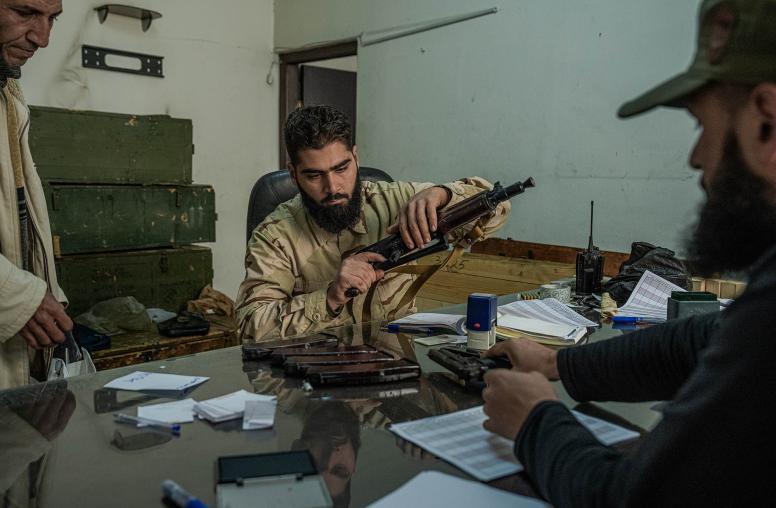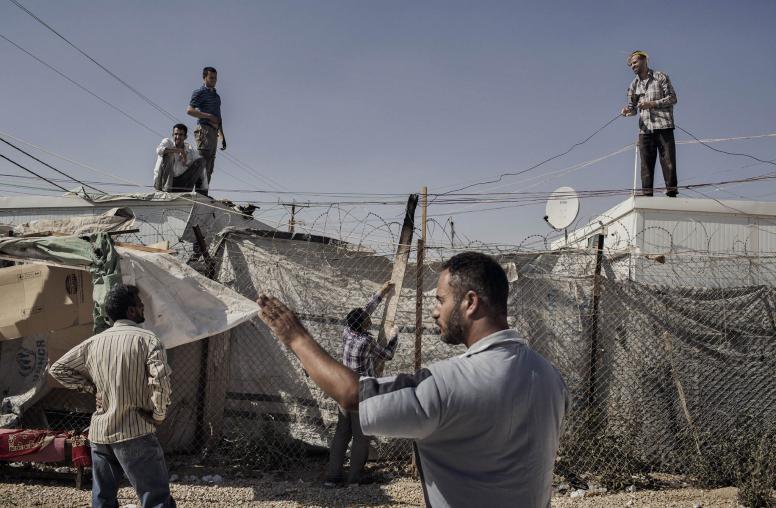Coronavirus Throws Another Challenge at Syria’s Doctors
Already beleaguered from years of conflict, Syria’s medical professionals gear up for COVID-19.
As COVID starts to surge in Syria, the pandemic poses extraordinary challenges in one of the world’s most complex conflict zones. Nearly a decade of war has left Syria’s health care system in shambles. With supplies and trained personnel scarce, medical providers have struggled to meet the needs of millions of displaced Syrians. Meanwhile, medical workers have not been spared from the violence—despite international condemnation, health care facilities have been targeted by military strikes over 500 times since 2011.

“Just going to work is a threat,” said David Lillie, executive director of the Syrian American Medical Society (SAMS), a humanitarian relief organization that works in Syria and surrounding countries to provide medical care. Now, as the coronavirus finds a foothold in Syria, doctors on the front lines are preparing for the daunting challenge of fighting a deadly pandemic in one of the world’s most war-torn regions—a challenge they expect to meet head-on. “Despite the threats and COVID-19, life must go on,” Lillie said at an online event hosted by the U.S. Institute of Peace.
How Much Has COVID-19 Spread in Syria Already?
It remains difficult to get an accurate picture of scope of the pandemic in Syria. “Unfortunately, we have to speak about Syria in terms of different regions,” as control of the country is fractured among many actors, said Dr. Bachir Tajaldin, senior program manager for Turkey at SAMS.
Some reports indicate Syria experienced its first cases as far back as mid-March, but that the Assad regime stifled any confirmation the virus had spread, at least in government-controlled areas, while implementing drastic containment measures.
Months later, the World Health Organization (WHO) has confirmed 892 cases and 46 deaths as of August 5—with a vast majority contained to government-controlled territories. But the reliability of those figures is suspect as testing capacities remain lacking and the Syrian government actively suppresses information about the disease. “The circulation of the virus is higher than the reported cases, and that is what we know from our colleagues, friends, and family inside Syria,” said Tajaldin. But even with questionable data, Syria has fared relatively better than regional neighbors such as Turkey, which recently passed 200,000 confirmed cases.
In the country’s northeast, home to the al-Hol camp that holds nearly 70,000 people who lived under ISIS, the virus was only detected recently. “The fears became true two days ago. There were three confirmed cases in al-Hol camp,” said Dr. Mohammad al-Haj Hamdo, SAMS health coordinator for northeast Syria. The cases were among NGO workers, and organizations active in the camp have taken steps to limit its spread—but it remains to be seen whether the measures will be effective. “We hope that these adjustments could help, but it’s a very difficult thing,” said Hamdo.
Meanwhile, the first case in Syria’s northwest wasn’t confirmed until July 9. While many suspect a lack of testing may again be masking larger outbreaks, the northwest’s initial ability to fend off the virus can be attributed, in part, to border closings between Syria and Turkey from March to June. “I can say that northwest Syria was isolated from the world from March to the beginning of July,” said Dr. Hamza Alsaied Hasan, SAMS quality and development manager for northwest Syria.
But clusters of the virus have begun popping up in the region. “When the borders opened in June, we expected the first cases in July, which is what actually happened,” said Hasan.
While predicted, the arrival of COVID-19 in northwest Syria has reignited concern over the region’s ability to weather the pandemic. Home to over 4 million people, one-third of whom currently live in overcrowded displacement camps, northwest Syria is particularly vulnerable to a widespread outbreak of COVID-19, leaving doctors in the region fearful of being overrun and overburdened.
Displacement, Poverty, and the Psychological Impact of COVID-19
“Every day I work in northwest Syria, I see new camps … northwest Syria is a sea of camps,” said Hasan.
Currently, there are 6.6 million internally displaced persons in Syria, with another 5 million refugees living in other countries. This seismic shift in population has created a major humanitarian crisis, with many Syrians living in overcrowded displacement camps or makeshift shelters.
And within the camps themselves, conditions were deteriorating even before the threat of COVID-19. Many camps lack basic sanitation supplies, and a decimated economy has left many Syrians in poverty. Without a substantial influx of aid, even the most basic preventative measures remain out of reach for many Syrians. “It’s a challenge for us,” said Hasan. “When I sent community health workers to raise awareness in some camps … the people answered that they have no money to buy masks.”
Poverty and displacement don’t just pose a risk to Syrians’ physical health—doctors are quick to include its psychological impact as well, as there are reported increases in depression and anxiety among displaced populations. Dr. Amjad Rass, chairman of the SAMS Northern Syria Medical Relief Committee, says part of their response has focused on creating mental health programs to deal with the effects of isolation, quarantine, and fear stemming from COVID-19.
The Need to Keep Doctors Healthy
Syria has a startling shortage of doctors. “It’s maybe a little over one doctor per 10,000 people, whereas typically it’s about 25 doctors per 10,000” in other parts of the world, said Mona Yacoubian, senior advisor for the Middle East and Africa at USIP.
For Syria to manage the coronavirus pandemic, it will need to protect its medical personnel to avoid even further shortages. “Our priority in our preparedness plan was how to keep health care workers healthy … and also prevent health care facilities from becoming a source of infection,” said Tajaldin.
Additionally, SAMS has been coordinating with the WHO and others to formulate a cohesive response to the pandemic, despite fractured political control in the country.
Drawing from their vast experience, SAMS is focused on improving ICU and ventilator capacities throughout the country, as well as instituting trainings so doctors have the most up-to-date information on treating the virus. Using their response to chemical weapons attacks as a model, SAMS has built a program that allows doctors in the United States to host lectures with their colleagues in Syria, and Rass has been astounded by the support he’s received: “I literally have more lecturers than courses.”
However, not all regions of Syria have been able to overcome hurdles to coordination. Hamdo says that while they’ve found some success in imposing movement restrictions and other containment measures in places like Raqqa, the tribal nature of authority in the northeast has made the process ad hoc and disjointed.
Meanwhile, a lack of supplies and facilities still inhibits any large-scale effort to contain the virus. In Raqqa, only 25 percent of the health centers are ready to use. This logistical challenge has only been made worse by the recently imposed Caesar sanctions. These U.S. sanctions were meant to target the Syrian regime, but their reverberating effects have caused costs to skyrocket. “The only [open] border was with the government of Syria. After the Caesar law, the prices of medicines and supplies increased maybe 500-600 percent, in addition to the cost of shipment,” said Hamdo.
Early Success Stories Create Hope
Despite the daunting challenge, medical professionals in northwest Syria are heartened by how they handled the first confirmed cases on July 9. “Unfortunately, the first cases were in one of the biggest hospitals in northwest Syria,” said Hasan.
Hasan and SAMS were able to shut down the hospital’s operations and isolate all patients, visitors, doctors, and staff that had been in the building. Coordinating with other organizations, SAMS confirmed 13 new cases that stemmed from the initial case within one week, signifying significant spread. But with effective contact tracing and isolation, they were able to snuff out the cluster and no new cases have been reported in the last two weeks. Meanwhile, the hospital has reopened less than a month after the initial outbreak. “We turned this bad story into a success story in our response to COVID,” said Hasan.
Another outbreak was also quickly traced by SAMS and frontline doctors, with no new cases attached to that cluster since July 25. With two clusters currently active in Aleppo, Hasan says they’re taking the same approach with the hopes that they can continue to trace the virus before it can spread widely. However, even with these early successes, doctors in Syria will need more comprehensive aid and support if the country is to weather the COVID-19 pandemic.


